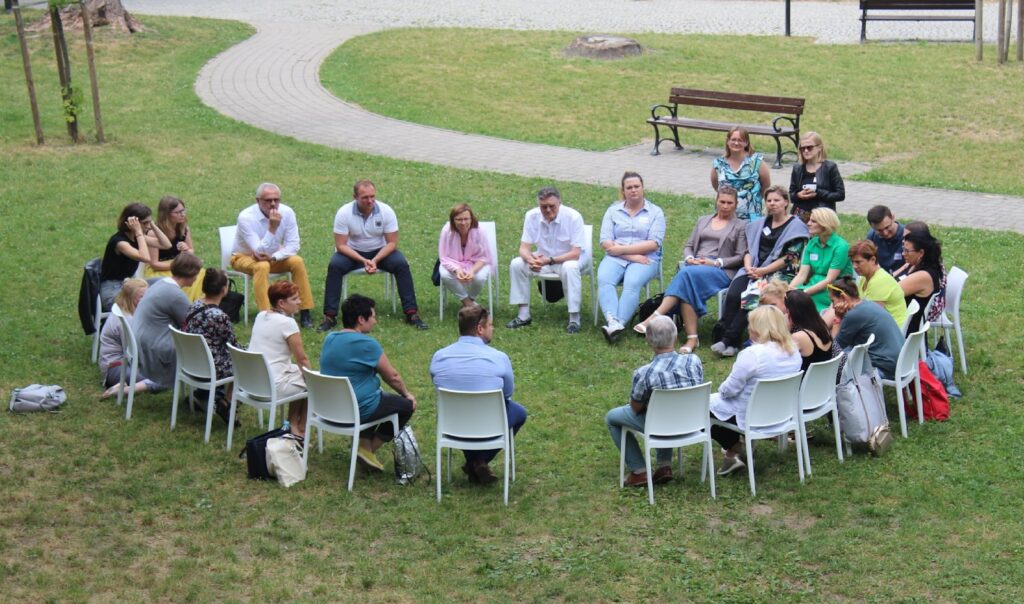Introduction; The Concept: ‘Tie-it-all-together’
Once you have your data in hand, created your logic model, and selected your impact indicators, your next step is to tie it all into a meaningful report. This is where numbers, quotes and lessons come to life for your stakeholders. A well-crafted report is not merely informative; it is inspiring.
This final post in our series will guide you through implementing that structure to your findings, using narrative and visualization to tell your story, and presenting results in a way that will inspire action. Whether you’re addressing a board member, a funder or a program participant, the objective is the same: you need to stand in front of your audience and assert with clarity and confidence that your organization delivers positive change.
In order to have Strategic Clarity, you must ORGANIZE
Start with a clear structure. Avoid the temptation of squeezing every chart and quote into your document. Rather, think as a storyteller. Your report needs a beginning (what the report is about), a middle (what you found) and an end (what you’re going to do next).
Sub-organize your results by program, theme, or outcome area as appropriate for your audience and your purposes. Some organizations simply use the framework of their Theory of Change (Inputs > Activities > Outputs > Outcomes > Impact) to categorize results. Others might organize by what they refer to as strategic priority (e.g., Youth Empowerment, Community Health, Economic Mobility).
Within each section, include:
- A headline finding
- Supporting quantitative data
- A quotation and/or anecdote that shows the shift
- A reading of what is meant
It’s a matter of achieving a degree of credibility while maintaining clarity. Not all readers will naturally understand chart relevance. Tell them explicitly.
Humanize the Data With Stories
Numbers give the scale and the exactitude, but stories give the emotional link. Narrate some examples, testimonials or case studies about how your work impacts real people’s lives.
Each should include a clear protagonist (an individual the program participant) who faced a challenge, how your organization helped them, and what the end result was. Ideally, tie the tale to a metric or an outcome.
For example:
“Jamal enrolled in our job readiness program in March 2023. A single dad who was recently laid off, he rated low on our initial confidence scale. At the end of the eight-week course, his score went up 47 percent, and he got a full-time job with benefits.”
Deploy these stories not just as feel-good moments, but as proof. Woven in with your quantitative wonders, they give a portrait of your impact in 3D.
Utilize visual to draw him in
It’s not just the looks that matter for visual design – it’s the functionality, too. Powerful infographics, dashboards, and charts help readers digest complex information more quickly — and remember it long after they have finished the book.
Some best practices include:
- For changes over time, use bar or line charts
- At a Glance, Are Better: Use pie charts or stacked bars, too for percentages
- Use outcome maps to identify which activities led to which results
- Pull out important quotes in boxes
Most social impact assessment instruments provide predefined dashboards and exportable chart. Leverage them to drive your points home and add some dynamism to your report.
Draw Insightful Conclusions
So now that you have these results before us, what do they mean? Summarize your key insights:
- What worked well and why?
- Where did you fall short?
- What surprised you?
- How does this learning apply to your next actions?
And make sure you separate data that describes (what happened) from data that guides (what you’ll do with what happened). Here is where your reporting goes from being a round-up to a strategic asset.
Provide a sub-section detailing:
- Lessons learned
- Modifications of programmes or interventions
- Routine follow-up or data collection intended
Transparency builds trust. And don’t be afraid to communicate what isn’t working. Admitting to holes or limits will only make your claims of success seem even more credible.
Tailor to Your Audience
Try multiple formats of your report:
- A technical full report for internal use or detailed funder scrutiny.
- A 2-PAGER for members of the tried and true board of Effective Deals.
- A visual one-pager for donors (or social media)
AND Different Audiences; Different Depths
Some audiences are more demanding of different perspectives. Your social impact assessment tool also should be able to generate these formats through customized templates and export functions.
And be explicit about what happens next. Include a call to action:
- Ask stakeholders for their input
- Invite funders to renew or expand support
- A NEWSLETTER BONUS Tell readers to forward the report
A successful report does more than just inform – it motivates collaboration.
Get the Most Out of the Tool You’re Using
Your social impact assessment tool should be about much more than data collection. It should aid you in arranging and delivering it well.
Look for features such as:
- Real-time dashboards
- Custom report templates
- Export to text, PDF, Excel or visual representations
- Narrative Tagging and Linking to the Narrative.structure.
- Audience or segment data filtering
Leverage automated visualizations and story-mapping for Pulse or a similar tool. These are the features that enable you to move from static reports to an interactive and living storytelling toward impact.
A powerful tool facilitates movement from ad hoc reports to ongoing impact learning. Not just to report results, but to iterate and to improve over time.
Final Thoughts: Your Report Is a Bridge
Your social impact report is not the final step in a process, but the first step in a conversation. It serves to build a bridge between your mission, and the community that supports it.
When it is properly made, a report does more than show that your work is legitimate. It empowers your staff, reassures your funders, and connects you more deeply to the communities you serve.
In part three of the series, we’ve walked you through how to go from setting assessment goals and metrics to collecting and organizing data to presenting key findings in an engaging way. Now you have the system that allows you to take data points that are all over the place and create an influence-proving argument.
Now it’s your turn. Utilize your social impact evaluation tool as a dashboard and a mirror of how your mission is manifested. Reflect deeply. Share generously. And let the proof of change illuminate the way forward.



